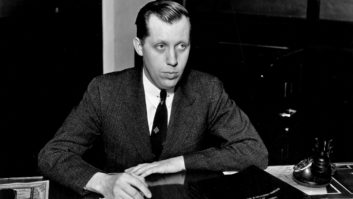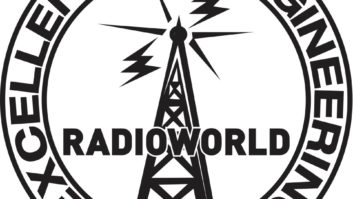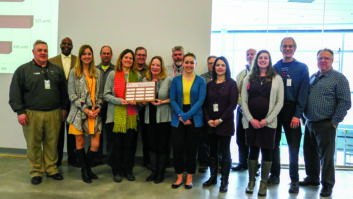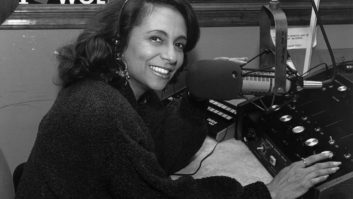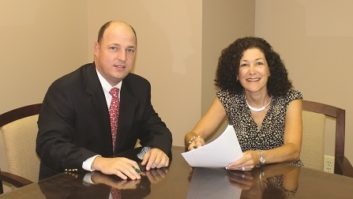Funny. Brash. No-nonsense. Unpretentious. Sentimental.
(click thumbnail)Lyons explains Durst’s communications system for emergency first responders at a press conference with city officials this spring. Photo by Steve Friedman These are characteristics we love in native New Yorkers, and they are attributes of John Lyons, recipient of the 2006 Radio World Excellence in Engineering Award. Honorees represent the highest ideals of the U.S. radio broadcast engineering profession and reflect those ideals through their contributions to the industry.
Lyons, 57, is assistant vice president and director of broadcast communications for The Durst Organization in New York; you’ve read about him in our pages. To me, John more than fulfills the definition of excellence in engineering.
His most obvious recent contribution has been his exceptional work in developing and managing the master broadcast antenna facility atop 4 Times Square at a time when the city has been most in need of such capabilities.
His thumbprint, in fact, is all over New York radio, and we salute his career-long service to the broadcast community there as well as his involvement in numerous professional organizations. His selection five years after the Sept. 11 terrorism is particularly fitting; Lyons played an important part in the return to the air of many New York broadcasters after the attacks.
Something new
Talking by phone – coincidentally on the anniversary of 9/11 – I asked John how he’d characterize his career path. “Being flexible,” he answered, and commented on the pace of technology change in broadcast over four decades.
“As people get older, a lot of them just can’t deal with it. My mother was looking at the TV one day and asked me, `What’s all this damn dot-com stuff?’ It was hard to explain it to her, even when I showed her on a laptop. Here’s a woman who spent her career on a Remington typewriter.
“A lot of broadcast engineers did that in their careers. They could deal with a tube transmitter, or maybe even a solid-state console; but then it all changed. Whether it’s a BE AudioVault or the latest Prophet system, a lot of people fell by the wayside rather than deal with it.”
Lyons’ motto is “learn something new every day,” and he has lived it.
He started in radio at WNYE(FM) at Brooklyn Technical High. Asked to cite his biggest influences, he names Joe Losgar, who as director of engineering for Bonneville’s WRFM(FM) “gave a kid with a license and no experience a chance to work. And I’ve been doing it every day for 40-plus years since. I’m dedicating this award to him.”
Lyons worked for Losgar as a transmitter operator and studio engineer. He then spent nine years as chief studio technical operator at WWRL(AM) and concurrently was director of engineering at ZDK Radio in St. John’s, Antigua, an AM/FM station he built.
He moved to WOR(AM) to be assistant chief. Owner RKO-General soon promoted him to become chief engineer of WXLO(FM), later renamed WRKS. He worked for over a decade there under a second notable influence, George Capalbo, vice president of engineering for the radio division of the company, which owned the maximum number of stations: seven each AM, FM and TV.
“He believed in us, the seven chiefs. He had one pretty neat bunch of engineers working together. We did a lot of firsts in the ’70s and the ’80s that are now taken for granted.” For example, Lyons remembers experimenting with early telephone talk modules built into consoles, in cooperation with Jack Williams of Pacific Recorders.
In 1990, John left WRKS to join DSI Communications – today DSI RF Systems – where he was senior project manager, responsible for communications facility build-outs including TV and radio transmitter facilities, two-way, point-to-point microwave and satellite systems.
Four years later he took a consulting position at Sony Worldwide Radio Networks, then a new outfit, where he established standards for a nationwide satellite-programming network, built studios and developed its operations system. He went to WLTW(FM) as assistant chief engineer, then was promoted to chief of WAXQ(FM). This was with Viacom; the station was later sold to Chancellor and eventually became part of Clear Channel.
Durst
Earlier in the 1980s, when he was with RKO, Lyons had chaired the Master FM Broadcasters Committee at the Empire State Building, coordinating operations of 13 FMs there and at the World Trade Center. He resumed that chairmanship for four more years in the ’90s and was design engineer for many Chancellor/Clear Channel operations including the five-station backup FM site at 4 Times Square, a facility designed in part to be ready for Y2K – “the non-event of the millennium,” Lyons says wryly.
That backup, however, would keep WKTU(FM) on the air on 9/11.
Sept. 11 is never far from his mind. Lyons’ office is atop 4TS and he is well aware that he is working 715 feet above the street.
“As I’m sitting here in my office looking down at a void in lower Manhattan, it is still striking. This tower went on the air just about three years ago; stations have moved over to Empire, some still have backups at Alpine and various other places; but still there is no building downtown. It’s difficult.”
For the most part, New York’s broadcast engineering community, he says, is tight-knit, and demonstrated it when six members died at World Trade.
“We’re all there for each other. Let the program people fight out the ratings; the engineers will watch out for each other. That was proven five years ago. Hopefully it’ll always continue to be that way.”
After the attacks, Lyons was one of those scrambling. He worked with Empire, 4 Times Square, broadcasters and contractors to restore broadcasting operations for all of the orphaned World Trade stations. He designed transmission line runs, laid out transmitter plants and assisted the stations to return to the air as soon as possible.
In 2002 Durst brought him on as manager of communications and broadcast operations to redevelop and expand the capabilities of the transmission facility atop 4TS.
He oversaw removal of the 132-foot master FM antenna tower and its replacement with a 385-foot master TV/FM antenna tower, one that could, in theory, accommodate every TV and FM station licensed to the New York metropolitan area. The facility also can handle point-to-point microwave, spread-spectrum, broadband, two-way, STL/TSL, RPU and ENG services. As I’ve reported, it’s an impressive place, now home to one FM main transmission facility, nine FM backups, two TV mains, three TV backups, the city’s Qualcomm/MediaFlo site and sundry point-to-point and broadband services, as well as an STL/TSL hop for WOR.
Though he’s “just” the site manager, broadcasters ask him all the time to handle adjustments or problems with their facility. He’s up there already; and he knows what he’s doing.
In 2005 he was elevated to responsibility for communications needs of the company’s 10 million-square-foot portfolio of buildings. He continues to innovate. He has spent two years establishing a state-of-the-art communications system for first responders, now in place in the Durst buildings, which will benefit firefighters and EMS personnel and protect Durst’s tenants and properties. That alone is a huge accomplishment. Meanwhile, his design for RF monitoring and safety at a multi-user communications facility is a topic of attention at national and regional engineering conferences.
Impish maverick
Long lists of career memberships can be easy to skip over, but think about them: Lyons is active with the NAB Broadcast Engineering Conference Committee. He is a Fellow in the SBE and a Certified Professional Broadcast Engineer, and a former member of the board of directors and original member of the certification committee of SBE.
He also is a Master Certified Engineer in both RF and non-RF disciplines with the National Association of Radio and Telecommunications Engineers; an associate Member of the Association of Federal Communications Consulting Engineers; a member of the National Association of Broadcasters Broadcast Engineering Conference Committee; and former president of the Veterans’ Hospital Radio and Television Guild.
I know him to be a devoted family man. A New York native, he met his wife, Natasha, in Siberia – yes, that Siberia.
“In my other life, I did competitive ballroom dancing and international dance photography.” (Where does he find the time?) “I was shooting the Russian dance championships in Bratsk, and she was one of the translators. Seven weeks later she was in America, and we were married shortly after. That was 14-1/2 years ago.”
Their son Matthew, 13, is in 8th grade – “an overachiever, maybe like me” – and is a junior PGA golfer.
In recent years Lyons’ career has taken another fascinating turn. When he came to Durst, he realized he was working for a real-estate company and knowledge of the industry would help immensely. “I can’t sell the company if I can’t sell myself,” he says. So he went back to school, studying at night, and is now a Licensed New York State Real Estate Broker and a member of the Real Estate Board of New York as well as the Building Owners and Management Association; he also has a Certificate in Property Management from New York University. This, however, has not kept him from remaining an active and involved part of the broadcast engineering community.
I asked John how others would describe him. “I don’t think we can put that into print,” he replied. Pressed, he answered, “`Maverick.’ That was a word George Capalbo used.” It’s a trait Lyons appreciates and would seek out when hiring an engineer. “That’s what I’d look for: someone who thinks a little outside the box, has a little sparkle in their eye and is a little impish.”
That’s John.
His goal is to continue improving 4 Times Square and to attract more tenants. He’d like the facility to be considered the standard for multi-user sites, particularly in its management of RF safety. He wants it to be a design the FCC can point to as a model.
His career advice for other engineers? Keep learning. “I say that to my son: Learn one new thing every day before you go to bed. I still do that myself.”
Whether it’s designing remote input selectors for Gates Yards and BE Spotmaster boards in the 1970s, or developing a $25 million skytop site in the new millennium, Lyons has innovated. He’s a perfect choice for the 2006 Radio World Excellence in Engineering Award.






